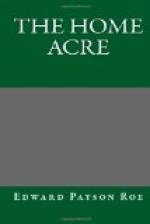The chief insect enemies are onion maggots, the larvae of the onion fly. These bore through the outer leaf and down into the bulb, which they soon destroy. I know of no remedy but to pull up the yellow and sickly plants, and burn them and the pests together. The free use of salt in the fall, and a light top-dressing of wood-ashes at the time of planting, tend to subdue these insects; but the best course is prevention by deeply cultivating and thoroughly enriching in the fall, leaving the ground rough and uneven for the deep action of frost, and by sowing the seed very early in spring. I have found that the insect usually attacks late-sown and feeble plants. If the maggot were in my garden, I should use the little sets only.
Some special manures have been employed in attaining the greatest success with this vegetable. In England, pigeon-dung and the cleanings of the pigsty are extensively employed. In this country the sweepings of the hen-roost are generally recommended. It should be remembered that all these are strong agents, and if brought in contact with the roots of any vegetable while in a crude, undiluted state, burn like fire, especially in our climate. What can be done in safety in England will not answer under our vivid sun and in our frequent droughts. These strong fertilizers could be doubled in value as well as bulk by being composted with sods, leaves, etc., and then, after having been mixed, allowed to decay thoroughly. Then the compost can be used with great advantage as a top-dressing directly over the drills when either sets or seeds are planted. The spring rains will carry the richness from the surface to the roots, and insure a very vigorous growth. When the compost named in the early part of this paper is used, I sow it thickly in the drill, draw a pointed hoe through once more, to mingle the fertilizer with the soil, and then forthwith sow the seeds or put in the sets one inch deep; and the result is immediate and vigorous growth. Wood-ashes and bone-dust are excellent fertilizers, and should be sown on the surface on the row as soon as planted, and gradually worked in by weeding and cultivation during the growing season. Manure from the pigsty, wherein weeds, litter, sods, muck, etc., have been thrown freely during the summer, may be spread broadcast over the onion bed in the autumn, and worked in deeply, like the product of the barnyard. The onion bed can scarcely be made too rich as long as the manure is not applied in its crude, unfermented state at the time of planting. Then, if the seed is put in very early, it grows too strongly and quickly for insects to do much damage.




